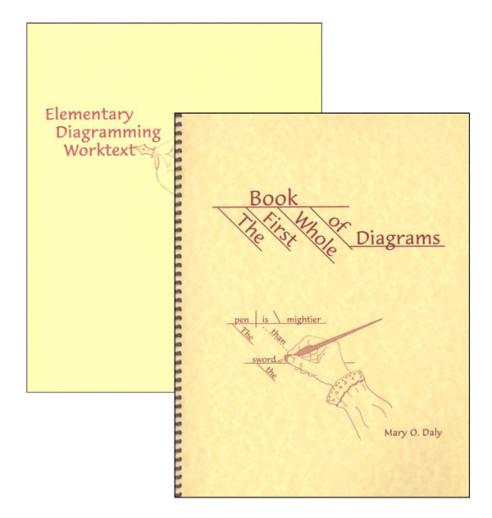We use cookies to make your experience better. To comply with the new e-Privacy directive, we need to ask for your consent to set the cookies. Learn more.
Elementary Diagramming + First Whole Book
Learning how to diagram sentences can really help students visualize how the different parts of speech work together to form sentences. However, this skill isn't always included in English books. This workbook provides a wonderful supplement to any curriculum. It covers sentence diagramming from easy to challenging, one step at a time. After reading simple explanations and seeing examples, students practice with similar sentences. The worksheets start with just subjects and predicates and then progress to adjectives, adverbs, direct and indirect objects, appositives, interjections, prepositional phrases, participles, and gerunds. Reviews are scattered throughout, which can be used as quizzes or test if desired. The worksheets are perforated and reproducible. Answers included, 46 pages. - Melissa
These materials provide a thorough coverage of sentence diagramming, and they are perfect to supplement any grammar curriculum. The First Whole Book of Diagrams is essentially a diagrammer's reader. It simply holds pages and pages of diagrammed sentences. The pages are divided into sixteen chapters, each progressing in difficulty (new parts of speech are added to the diagrammed sentences). In the first chapter, the majority of the sentences are merely composed of a subject and verb. Subsequent chapters add articles, adjectives, direct objects, adverbs, prepositions, subordinate clauses, and other parts of speech. Students simply read through the pages, acquainting themselves with the diagramming language. A teacher's manual is included, providing thorough explanations of each part of speech, information about how they are diagrammed, and scripted conversations to engage in with the student. Spiral-bound, 212 pgs.
The Elementary Diagramming Worktext provides actual practice in diagramming sentences. It follows much the same progression as The First Whole Book of Diagrams, beginning with just subjects and verbs. However, this book holds just eight chapters and does not cover the more challenging concepts. In addition to subjects and verbs, it covers articles, adjectives, direct objects, linking verbs, adverbs, and prepositions. The worksheets offer thorough explanations and examples, plus plenty of exercises for children to complete. Children should be able to complete this book with little help from a teacher. 72 pgs, not counting the included answer key. - Melissa
This set includes:
| Product Format: | Product Bundle |
|---|---|
| Brand: | Rainbow Resource Center |
| Grades: | 3-8 |

